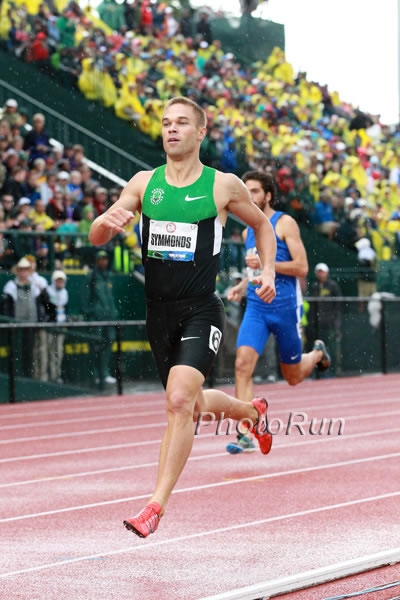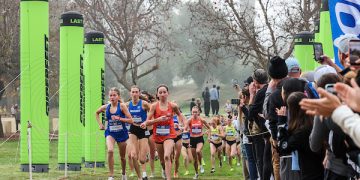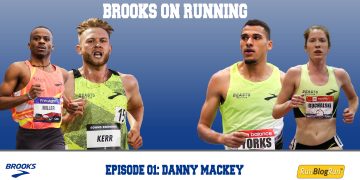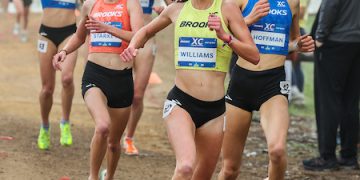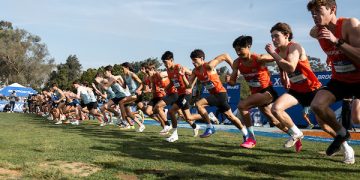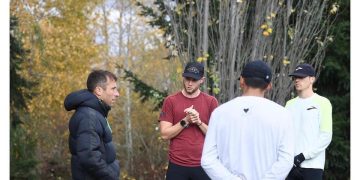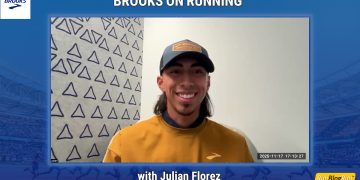Saves the Day
Can Nick Symmonds lead track and field athletes to the Promised Land?
by
Jon Gugala
It’s Friday night. Nick Symmonds calls to ask if I’d like to come over and watch him clean his guns.
Symmonds, the six-time national champion at the 800 meters (2007, ’10, Indoors; 2008-’11, Outdoors), answers the door in a white v-neck undershirt and baggy basketball shorts. I follow him to the dining room where on the table are a rifle and a nine-millimeter pistol in various states of disassembly, the cleaning gear scattered about.
Symmonds lives in a house near one of the highest points in Springfield, Ore., just across from Eugene, and as we sit down, we look out through the picture windows southwest across the river to the University of Oregon and Hayward Field, the site of his two Prefontaine Classic 800m wins and three of his four consecutive outdoor championship titles. It’s also the site of the 2012 Olympic team trials in June, where he’ll pursue a spot on what would be his second consecutive Olympic team.
Symmonds, who grew up on 12 acres outside of Boise, Idaho, is an outdoorsman. He hunts; he kayaks; he surfs when the tides are right. His garage is a bachelor’s tangle of disused sports equipment. Today is Friday, his day off, and after an easy six miles in the morning on the soggy woodchips of Pre’s Trail near the river, he drove an hour north to a remote fishing spot. But it’s March in Oregon and the incessant rain has transformed the rivers into turbid chocolate milk, so after a few perfunctory casts, he got out his guns and the colored targets that explode on contact from his truck and, as he says, “started shooting on something.”
But before Symmonds can dig into his cleanup tonight, his cell phone rings. It’s his agent, Chris Layne, who’s been with him since his breakout race at the USATF Championships in 2006 where, freshly graduated from D-III Willamette University, he was the surprise 800m runner-up to defending champ Khadevis Robinson.
Symmonds puts Layne on speakerphone, who says a writer from Time Magazine is doing an article on fundraising in athletics and wants to tie in Symmonds’ story. “Can I give him your cell?” Layne asks.
This is the other side of Symmonds: the spokesman. On September 30, 2011, still jetlagged from the 2011 World Championships in Daegu, South Korea, where he finished a career-high fifth, he started a Facebook group titled “Im [sic] tired of USATF and IAAF crippling our sport.” It was originally motivated by a request from his sponsor Nike for their athletes to tweet disapproval for the since-reversed IAAF decision to nullify all women’s road racing records that included men in the race’s start. Symmonds simply combined it with sponsorship issues that he and his friends had been talking about for years.
Symmonds’ main grievance with both governing organizations centers the sovereignty of the athlete’s body and who decides what can be displayed on it during competition. At the point when he started the group, USATF, following IAAF guidelines, was enforcing the two-logo limit on the singlet, which permitted a manufacturer logo–likely the athlete’s shoe sponsor–and a club affiliation. And that was it. There was nothing else allowed on either the singlet or the skin of the athlete. That, he says, is ridiculous.
The problem is that because of this limited ability to visibly promote additional sponsors, Joe Track Athlete has trouble recruiting additional sponsors. Moreover, that shoe company now has exclusivity that it hasn’t paid for. If the shoe contract is not enough, the athlete’s financial situation becomes tenuous at best, necessitating them to take on a supplementary job–the modern evolution of the shamateurism system of the 80s.
Symmonds’ offhand action ballooned to 4,000 members within 24 hours, and within a week had surpassed 6,000. And it wasn’t just elite athletes who rallied; many were just ordinary fans hearing about these issues for the first time. It began his unlikely role of athletic activism, which has arguably brought more stature to him than his running performances have ever done.
“Yeah, give him my number,” Symmonds says to his agent. “I’ll be in all night tonight, but I’ve got a workout in the morning.”
Since that day in September, this has been Symmonds’ life, split between the very real training demands to accomplish his goals on the track and the less tangible ones he has for the sport’s future, the latter motivated by his senior age at 28, and the clichéd Boy Scout ethic of leaving something in a better state than which you found it.
Symmonds begins to clean again with an olive drab toothbrush over the metal, focusing on carbon buildup in its recesses.
“How many guns do you own?” I ask.
Symmonds pauses. “Well, I don’t know, because a lot of them are back home in Boise. But here I probably have five,” he laughs.
A political independent, Symmonds doesn’t only stray right on the issues of the Second Amendment; it’s present in the economics of his advocacy, where he is he is the quintessential capitalist. On January 4, in a move that would garner national attention–and not just from the running media–he put his left shoulder up for auction on eBay. The winning bidder would “own” the space for the duration of Symmonds’ 2012 track campaign, their Twitter handle displayed on a temporary tattoo when permitted.
It was almost performance art, a symbolic protest. And maybe that’s how it started, with Symmonds starting the bidding at $14.95 to break even on the cost of the tattoos. But fifteen days later when the auction ended, it was Hanson Dodge Creative, a marketing firm based in Wisconsin that targets the active lifestyle enthusiast, that ended up as the final bidder at $11,100.
Afterwards, one journalist asked if Symmonds would give the money to those in the sport less fortunate, since, after all, he was a four-time U.S. champion and therefore better off than most.
“That defeats the purpose,” Symmonds says, the metal clicking as he charges the weapon. “The purpose is to say, hey, we’re athletes that work our asses off, and we deserve to be paid accordingly. I’m out there in weather like this running ten miles a day,” he says, motioning with a rag to the rain and gloom through the window. “My running career is very, very short. Why wouldn’t I capitalize on all the different avenues possible?
“USATF isn’t setting up retirement programs for us,” he adds.
That is the line that Symmonds walks in his activism. He is a proponent of the Reaganomics trickle-down, the Ayn Rand ideal of ethical egoism that, in the pursuit of his own interests, will irrevocably change his landscape for the better.
After his Facebook group, which united the elite athlete plight to the track and field fan, there was progress achieved in all the issues, most notably at the 2011 USATF Annual Meeting in St. Louis, Mo. In a packed hall of athletes Symmonds had helped rally and now unexpectedly led, an IAAF representative announced the addition of an extra logo on competition uniforms that could be used for a commercial sponsor. USATF also agreed to suspend enforcement of IAAF uniform guidelines at USATF-run events, which included the 2012 USA Indoor Championships and the 2011 Club Cross Country Championships. And though the athletes’ resolution to challenge the USATF’s exclusivity clause in their contract was tabled to prevent a breach of contract with current sponsor Nike, it brought dialogue and awareness to an issue that will be revisited when current contracts expire and new negotiations begin.
Despite his work, Symmonds knows what his primary job is: “I have the same amount of hunger for an Olympic medal as ever. Just making the team is not enough. Any meet, other than a U.S. Championship or Olympic meet, is a glorified practice to
me,” he says. “The day I honestly think I can’t run a PR, I’ll hang my spikes up.”
Last year, Symmonds ran 1:43.83, five-hundredths of a second off his best of 1:43.76, set in 2010 in the same race that David Rudisha set the world record. But as Symmonds closes his second Olympic cycle as America’s best 800m runner, he’s thinking about the legacy he’ll leave behind. Sure, some of that is on this year’s Olympics and the medal that’s so far eluded him. But he’s still looking beyond. “There’s got to be more than just chasing medals,” he says. “Maybe I never win a medal, but maybe I make it possible for athletes to pursue reasonable sponsorships like they should be able to do. I think that in any movement there is a place for a renegade who’s not necessarily aligned with anyone, who doesn’t have any allegiance.”
“A maverick?” I ask.
“A maverick, sure,” Symmonds says as he puts his cleaning gear away. “There’s a spot for a guy like me who’s not afraid to just speak out.”
RelatedPosts
Author
-

Larry Eder has had a 52-year involvement in the sport of athletics. Larry has experienced the sport as an athlete, coach, magazine publisher, and now, journalist and blogger. His first article, on Don Bowden, America's first sub-4 minute miler, was published in RW in 1983. Larry has published several magazines on athletics, from American Athletics to the U.S. version of Spikes magazine. He currently manages the content and marketing development of the RunningNetwork, The Shoe Addicts, and RunBlogRun. Of RunBlogRun, his daily pilgrimage with the sport, Larry says: "I have to admit, I love traveling to far away meets, writing about the sport I love, and the athletes I respect, for my readers at runblogrun.com, the most of anything I have ever done, except, maybe running itself." Also does some updates for BBC Sports at key events, which he truly enjoys.
Theme song: Greg Allman, " I'm no Angel."
View all posts


